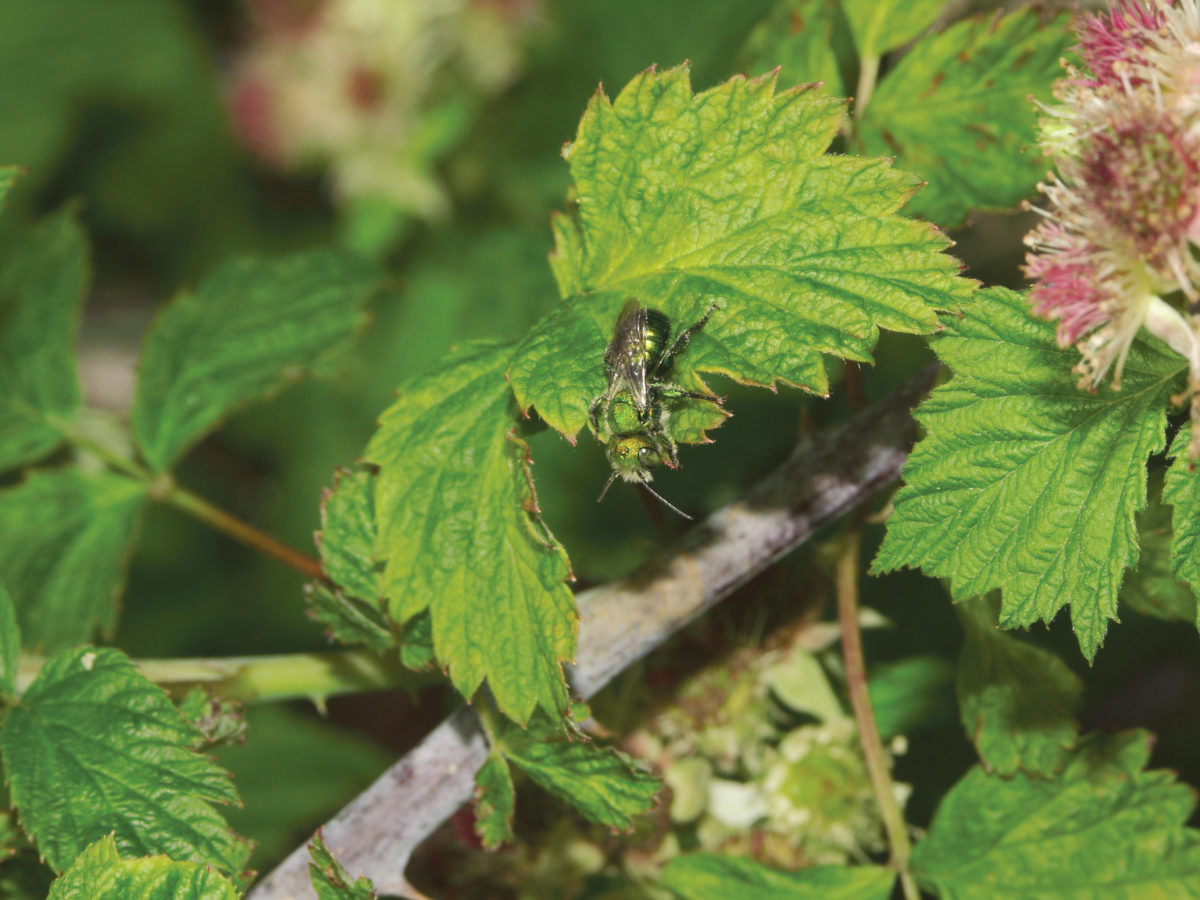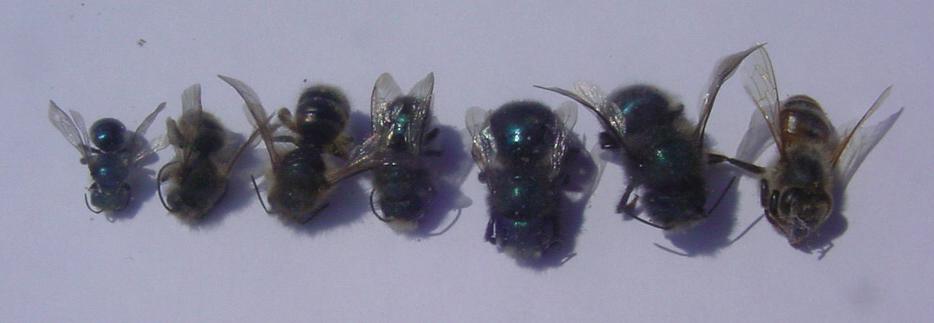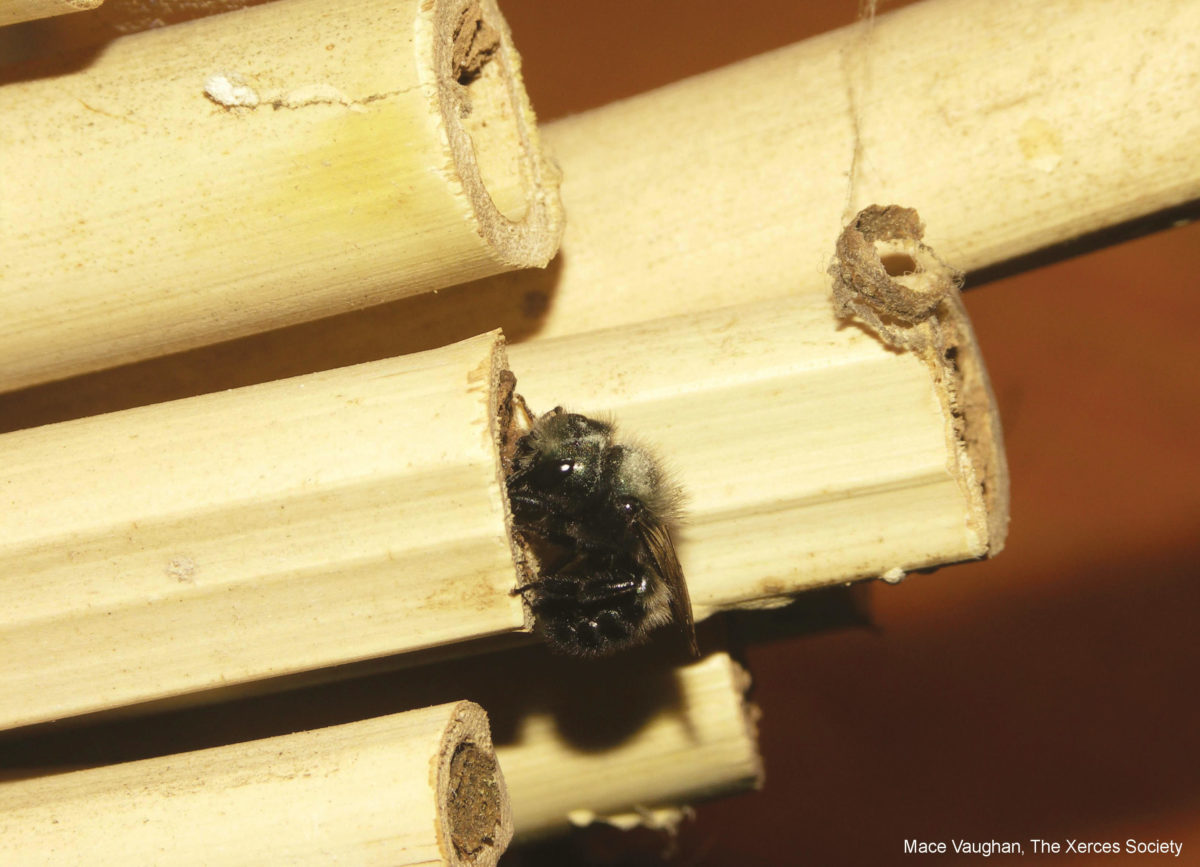Like the alfalfa leafcutter bee, mason bees belong to the family Megachilidae. As with other members of the Megachilidae family, mason bees use their large, scissor-like jaws to gather mud, pieces of leaf, or flower petals for the construction of their nests. All species of mason bee currently managed in the US belong to the genus Osmia. There are several hundred members of the Megachilidae family in North America, and dozens of members of the Osmia genus (including both native and nonnative bees). Currently only three species—Osmia lignaria, Osmia californica, and Osmia cornifrons—are commonly available from commercial suppliers. Other Osmia species are managed regionally.
All Osmia are solitary, meaning that each female bee independently constructs her own nest, provisions the nest with pollen, and lays eggs. There is no queen, and the bees do not live together as a social unit like honey bees do. Female Osmia do not interact with other bees or with their own offspring after laying their eggs.

Many Osmia are gregarious, however, meaning that they have a tendency to construct their nests near each other—hence large numbers of bees can be housed in a single structure containing multiple nests. Many Osmia species will nest in manmade nests, however most species are difficult to domesticate because they are not gregarious. Male bees have no role in the construction or the provisioning of nests. Upon their emergence as adults, males mate, then die soon thereafter. While they may feed on small amounts of flower nectar to maintain their own energy, male bees do not actively collect pollen, and have little value as pollinators.
Most native Osmia are 9/32 to 19/32 inch in length (~7 to 15 millimeters) with male bees noticeably smaller than females. The majority of North American species are metallic blue, black, or green in color although other color variations exist. All female Osmia have parallel rows of pollen collecting hairs, called the scopa, on the underside of their abdomen. Female bees also typically have a pair of horn-like projections on the lower face. Male bees do not have facial horns, but often have longer antennae and a distinctive tuft of white hair in the center of their face (Figure 6.2).

Despite having a stinger, female mason bees are not aggressive and rarely sting, even when handled. The sting is also much less painful than that of a honey bee. As a result beekeepers do not need any special protective equipment when working with Osmia. Male bees have round abdomens with no scopa or stinger (Figure 6.3).
The most commonly managed mason bee, Osmia lignaria, is a temperate species native to most western states from southern Alaska south to California and eastward to Texas and Montana—and to most eastern states from Maine south to northern Georgia. The eastern and western bees comprise two distinct subspecies Osmia lignaria propinqua in the West, and Osmia lignaria lignaria in the East. Few records of the bee exist in the central plains states, probably due to an absence of suitable nesting habitat, although intermediate forms between the two subspecies have been reported.
Osmia lignaria is commonly called the Blue Orchard Bee, or “BOB” for short. Female BOBs are roughly the size of honey bees, although rounder in shape and metallic blue (Figure 6.4). Male BOBs are similar but smaller with the characteristic tuft of white facial hair common to many Osmia species. BOBs are univoltine, meaning only one generation of offspring is produced each year. Currently, only the western subspecies of the BOB is commercially available from bee producers.

The second most commonly managed mason bee, Osmia cornifrons, or the hornfaced bee, is originally native to Japan. It was purposefully imported in the 1970s as a managed pollinator by the USDA Bee Lab in Beltsville, Maryland (see sidebar, below). Hornfaced bees are slightly smaller than the native BOB, and unlike many native Osmia, are brown in color with a striped abdomen and yellow scopa (as opposed to metallic blue or green). Like the BOB, the female hornfaced bee has a pair of horn-like prongs protruding from the lower face, hence the common name. Also like the BOB, the hornfaced bee is univoltine, meaning one generation per year. Hornfaced bees are not as widely available as the BOB, and most managed populations exist in eastern and midwestern states. Feral hornfaced bees have been reported in some areas. The least common commercially available Osmia species is Osmia californica. This species resembles the BOB, but emerges later in the season, and is parsivoltine—meaning that some individual adults emerge after one year, while others emerge after two years of dormancy. This species also uses masticated leaf pulp, mud, and nectar in its nest construction, as opposed to only mud used by the BOB and hornfaced bee. Osmia californica is native to the western US.
With the exception of Osmia californica, most managed mason bees are only active in early spring. Adult bees emerge from eggs laid the previous spring. The bees are active for only a few weeks, during which they mate, construct nests, lay eggs, then die. The larvae slowly transform into adults over the summer, and they remain as dormant adults through the winter inside their nest until the following spring.
Because BOBs and hornfaced bees are only active in the early spring, their practical application is limited mostly to early blooming fruit crops. Despite this, they are sometimes advertised as “garden pollinators” in various garden supply catalogs. A gardener depending on these species to pollinate late-blooming vegetables will have little success without significant manipulation of the bees’ natural lifecycle.
New Use For A Multi-talented Bee
While the hornfaced bee is typically associated with tree fruitproduction, its potential on othercrops is only recently being appreciated by a handful of people. Dr. ToddWest, an assistant professor of horticulture at West Virginia University(WVU) is one of them. With sup-port from USDA-SARE he has initiated an ambitious project that is introducing the bee to an entirely new group of fruit growers.
“Hornedfaced bees have the potential to be very useful and sustainable pollinators for blueberry production by small farmers in the Northeast Region of the US,” says West. “As compared to honey bees, which require year-round maintenance, the hornfaced bee requires minimal input and management. The hornfaced bees are only active for six to eight weeks from April to June which coincides with blueberry blossom time.”
As part of the program over 300 blueberry growers have been surveyed, and some will be provided with hornfaced bee cocoons and all of the necessary materials for management. The likes, dislikes, successes, and failures of those growers will be tracked and recorded over a two-year period. “Growers need to understand how to properly manage the bees and that the management practices are different than those of the honey bee,” he says.
So far the results have been promising. “Initial research trials in West Virginia indicate that population increases are possible with blueberry as the main pollen source.” But as with other mason beekeepers, West concedes that there are some significant management challenges ahead. “The main limiting factor that we have encountered is mite infestations in the paper tube nesting system. These mite infestations have a direct negative effect on bee populations.”
Ongoing research is being conducted at WVU to determine how to properly manage these mites, as well as trials of various commercially available nest systems.
West’s advice to blueberry growers interested in trying hornfaced bees for pollination?
“I would suggest to anyone interested in managing hornfaced bees to make sure that you use secure storage methods to ensure that your bee population is parasite free. Setting the bees out in the field at the beginning of blueberry bloom is also crucial.”
For more information contact:
Dr. Todd West
West Virginia University
Division of Plant and Soil Sciences
1090 Agriculture Sciences Building
Morgantown, WV 26506-6108 Phone:
(304) 293-6023 ext. 4336
Email: Todd.West@mail.wvu.edu
